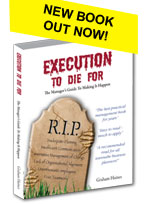1.2.3 Unique Selling Propositions And All That!
“Let your fingers do the walking”. “A Mars a day helps you work, rest and play”. Just two advertising slogans and memorable examples of a USP – Unique Selling Proposition. But, I can sense many of you thinking that USP’s are for consumer products and are just not relevant to your company’s products or services. Your customers are other businesses.
On the contrary, USP’s are vital, no matter what you supply.
When I was working in the explosives business, every time we developed a new product we would ask our advertising agency to produce a product brochure and would supply them with all the technical information together with a list of the product’s benefits. The agency would duly produce the brochure with tables, graphs and dot points by the score. Then one day, faced with the task of overseeing the production of yet another brochure for a major new product, a colleague of mine decided to approach an agency run by a personal acquaintance of his. The briefing meeting took place and as usual, we came prepared with all the same old information.
We were somewhat taken aback when the first question we were asked was who the target audience was for the brochure and after a lot of pointed questioning by the agency, we agreed that the key target audience was the miners themselves. At that time, the miners subcontracted themselves to the mining companies and were paid according to the amount of ore they dug per shift.
Now the new explosive was a packaged product resembling a large salami sausage but, unlike its major rival, ours was stiff and relatively hard rather than soft and drooping. These physical characteristics, as a layperson might have anticipated, made it easier for the miners to load our explosive into up holes in the roof of the area that they were mining.
The agency went away and returned a fortnight later with a storyboard of suspiciously modest dimensions. Velocity of detonation, specific gravity, energy and shelf life were all totally ignored. Instead the brochure focused on one thing only, the ease with which it could be loaded into up holes, given its Viagaran characteristics.
After much soul searching among the technical people and senior management, the OK was reluctantly given and the product was launched. It was a great success – product awareness was high and soon the miners were applying pressure to the mine management to purchase some for trials. The product lived up to its promise.
There was a sequel to this story. The market was Kalgoorlie and it was decided to produce a T-shirt as a giveaway. Our manager there started asking for more and more supplies, especially in the small size which was somewhat curious as most miners were big and brawny guys. He eventually came clean by explaining that the T-shirts were incredibly popular with the girls on Hay Street, given the slogan on the back of them that read “ the biggest bang in town”.
To be successful these days, you have to be different and better than your competitors but you have to encapsulate that difference by stressing one benefit to the customer over and above all others. The USP can reflect your company as a whole or it might apply to a particular product or service.
It does not have to be the core benefit particularly if there is little to choose between yours and competing products. It does have to be something that your customers value but it also has to be something that you have to a greater degree than your competitors. It’s by no means easy to define what that is and one reason is that you are too close to the company, product or service in question.
What brought this topic of USP’s to mind is that bpi has a new product close to launch and I have a list of ten benefits in front of me – all legitimate – but which one do I choose as the USP? What is THE hot button? As the agency account manager in the above story explained it - “If I throw you one tennis ball, there is a good chance that you will catch it but if I throw you ten simultaneously, the chances are you will drop the lot”.
A draft profile has been written on this new product but we need the equivalent of a flier and the shorter the document, the harder it is to create. There are two issues. The first is to identify the USP and the second is to express it in some memorable way.
The best way to identify the USP is to talk to customers who know your company and its products. Expressing the USP in words is a challenge as well. However, as a guide, memorable USP’s communicate with and engage the prospective customer. “Let your fingers do the walking”. “A Mars a day helps you work, rest and play” “It’s your money, Ralf”. They frequently encourage the reader to put their own interpretation on the words so the benefit is relevant to them. Nike’s “Just do it” is capable of all manner of subjective interpretations. Emotional appeals to the buyer’s intelligence and business judgement are more effective than rational appeals. “No one ever got sacked for buying IBM”.
Believe me, identifying that point of difference and exploiting it will become ever more pressing. If you don’t do this, and current and prospective customers regard you as “just another supplier”, then you will be reduced to competing on price – and there will always be someone who can produce it cheaper than you.






